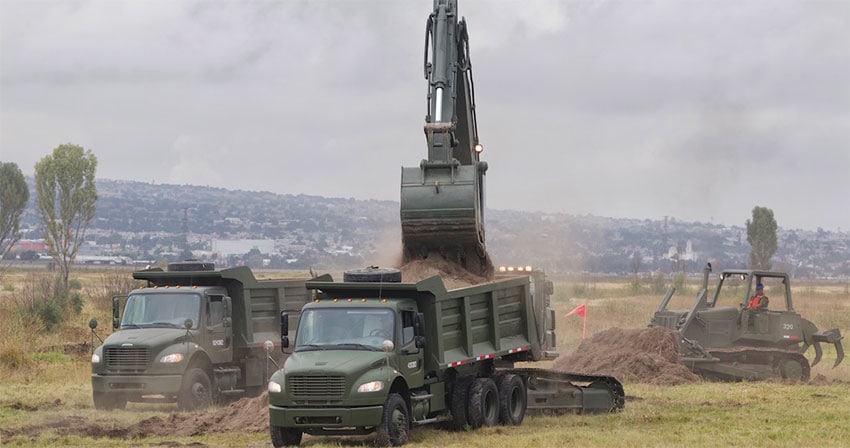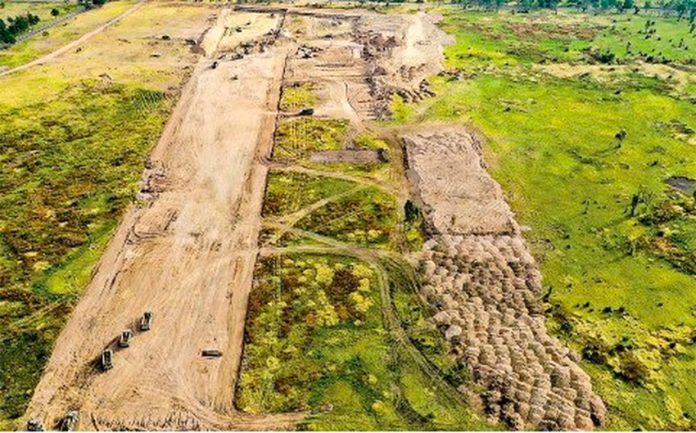A week after President López Obrador officially inaugurated construction of the Santa Lucía airport, progress is being made at the México state air force base site.
The newspaper Milenio, whose reporters visited the site located about 45 kilometers north of central Mexico City, reported on Friday that military engineers have made progress on the preparation of land for the construction of one of two new runways.
Machinery to lay the foundations of the runway is already on site as is a large team from the Secretariat of National Defense (Sedena), which is in charge of building the airport.
The two runways, to be built alongside an existing military runway, will enable domestic and international flights to take off and land simultaneously, Milenio said. The airport, which is expected to open in March 2022, will have a capacity of 20 million passengers annually in its initial stage of operations but capacity will eventually increase to 85 million passengers per year.
In contrast to what happened during the construction of the abandoned airport at Texcoco, where building materials such as the volcanic rocks tezontle and basalt were trucked in from nearby quarries – many of which operated illegally – clay, sand and gravel to build runways, taxiways and other infrastructure at Santa Lucía will come from the site itself.
Colonel Mario Alberto Pérez, who is in charge of a team of 455 military engineers, told Milenio that the onsite building materials are of “very good quality.”
He explained that personnel from the National Institute of Anthropology and History are currently working at the site to check for the presence of archaeological remains.
Pérez said that 17 separate projects will be executed simultaneously during the construction. Among them: the runways, a terminal building, a parking lot for 5,500 cars and maintenance hangars.
Existing military facilities will have to be relocated to make way for the airport and land adjacent to the site will be developed as an “airport city” with space for hotels, airline offices, banks, a shopping mall and a convention center.
Pérez said the airport “will be equipped with satellite technology” so that planes can land safely when fog hinders visibility.
The nearby Cerro de Paula, a 2,625-meter-high hill, will not affect the operation of the airport, he said.

The airport’s master plan was modified earlier this year due to the close proximity of the hill. The position of the two commercial runways was changed, meaning that several military facilities require relocation. The modifications to the plan caused the first overrun for the airport, increasing its cost by 11%.
Pérez said that building the airport is “a project of great magnitude” and explained that Sedena won’t be able to complete it on its own.
“. . . Although most of the engineers are here . . . we will need a complementary workforce,” he said. The government will launch a recruitment drive to attract the workers required.
To build a new road link to the airport, the government still needs to purchase several parcels of land surrounding the site. Pérez said 60% of 1,400 hectares that are required have already been acquired.
Construction was held up for several months due to legal action taken by a group that hoped to revive the abandoned project at Texcoco.
The last of seven suspension orders against the Santa Lucía airport was revoked on October 16 and the very next day, López Obrador presided over a ceremony to inaugurate construction.
The president estimated that the new airport will cost 75 billion pesos (US $3.9 billion).
However, once the expense of canceling the previous government’s airport project and other necessary outlays are factored in, the government will end up paying about 180 billion pesos (US $9.4 billion), López Obrador said.
Local residents have raised environmental concerns about the project and are particularly worried about the impact that the airport will have on already depleted water resources in their México state communities.
Source: Milenio (sp)
